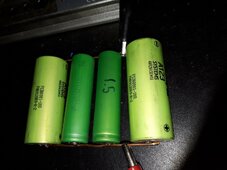400bird
Solar Wizard
Thanks to a gracious member here, I just picked up 48 LifePO4 cells that I plan to build into three 16s batteries.
I had I initially considered retiring my current battery bank (14s NMC)
But, now I'm reconsidering...
Please, let's stay on track. Can we please not discuss everyone's fear in these cells? I really don't want to be told that you don't trust them and wouldn't want them in your house.
They are outside the house, 5' from anything. Inside a metal box, lined with cement board, with a WiFi smoke detector inside. They are well protected with a BMS, shunt trip breaker, and fuses.
Anyways
If I limit charge on the LifePO4 cells to 3.5 volts per cell, the NMC cells will be fine (reaching 4 volts/cell)
On the low end, of I stop discharging the LifePO4 at 2.8 volts per cell, the NMC will also be fine (reaching 3.2 volts per cell)
As you can see, with slight limits to each cell voltage type (leaving some capacity on the table) all the cells can be kept in a happy range.
Sure, each chemistry has a different discharge curve, so at times all of the load will be on the LifePO4 cells and other times it will all be on the NMC bank. But, each bank can individually handle the load (6kW) or charging (7.5kW)
Each bank is individually >30kWh, so the loads are a relatively low 0.23c max
Wow, that was a lot of back story, on to the show.
My question:
Once LifePO4 has finished charging it naturally settles from ~3.5-3.65 volts down to something in the 3.3-3.4 volt range over maybe 10-30 minutes. However, the NMC won't do this and will likely hold the LifePO4 pack up near the 3.5 volt/cell range.
Should I be concerned about this?
I have a contactor/relay rated to 800VDC/600amps that I could use to disconnect and rest the LifePO4 pack until the NMC pack voltage has discharged down to match the rested LifePO4 pack.
If you read all the way through this, thank you!
I had I initially considered retiring my current battery bank (14s NMC)
But, now I'm reconsidering...
Please, let's stay on track. Can we please not discuss everyone's fear in these cells? I really don't want to be told that you don't trust them and wouldn't want them in your house.
They are outside the house, 5' from anything. Inside a metal box, lined with cement board, with a WiFi smoke detector inside. They are well protected with a BMS, shunt trip breaker, and fuses.
Anyways
If I limit charge on the LifePO4 cells to 3.5 volts per cell, the NMC cells will be fine (reaching 4 volts/cell)
On the low end, of I stop discharging the LifePO4 at 2.8 volts per cell, the NMC will also be fine (reaching 3.2 volts per cell)
As you can see, with slight limits to each cell voltage type (leaving some capacity on the table) all the cells can be kept in a happy range.
Sure, each chemistry has a different discharge curve, so at times all of the load will be on the LifePO4 cells and other times it will all be on the NMC bank. But, each bank can individually handle the load (6kW) or charging (7.5kW)
Each bank is individually >30kWh, so the loads are a relatively low 0.23c max
Wow, that was a lot of back story, on to the show.
My question:
Once LifePO4 has finished charging it naturally settles from ~3.5-3.65 volts down to something in the 3.3-3.4 volt range over maybe 10-30 minutes. However, the NMC won't do this and will likely hold the LifePO4 pack up near the 3.5 volt/cell range.
Should I be concerned about this?
I have a contactor/relay rated to 800VDC/600amps that I could use to disconnect and rest the LifePO4 pack until the NMC pack voltage has discharged down to match the rested LifePO4 pack.
If you read all the way through this, thank you!





